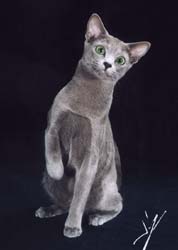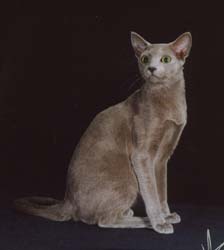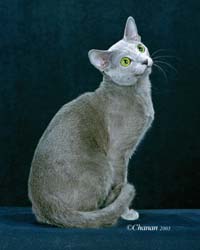
Webmaster:Snow-Island
Copyright 2004 russianblue.net
All rights reserved.
Link free,Please link to TOP. But do not link from adult & religion &illegal website.
Link free,Please link to TOP. But do not link from adult & religion &illegal website.
 |
|||||||||||||||||||||||||||||
First shown in 1875 at the Crystal Palace in England as the Archangel Cat, the original Russian Blue competed in a class for all blue cats. It was not until 1912 that the Russian Blue was given a class of its own. From its early origins until after World War II, English and Scandinavian breeders worked to develop the foundation bloodlines for the contemporary Russian Blue. Although Russians were imported to the United States as early as 1900, there is little recorded work with the breed in America until after World War II. American breeders combined the English bloodlines with their plush, silvery coats and Scandinavian bloodlines with their emerald green eyes and flat profiles to produce the Russian Blue we know today. In the 1960s the Russian Blue began to gain popularity and has become a favorite both at cat shows and at home.
Those attracted by the physical beauty of the Russian Blue find the disposition of these unassuming cats equally appealing. Russian Blues are quiet, clean cats who are playful and loving companions. Despite their shy nature, Russians are devoted and quite affectionate towards their loved ones. They are very intelligent and have been reported to open doors and teach their owners to fetch. Sensitive to the mood of the house, Russians will ‘clown to quiet a crying baby or sit patting your face to chase away the blues. They get along well with children and other pets. A Russian Blue is a good choice for the modern home because their undemanding nature fits perfectly into today busy schedules. They will entertain themselves if left alone for the day and be a contented companion upon your return. The Russian requires a minimum of grooming with periodic nail clipping and a coat that can be kept looking good by frequent petting and an occasional combing. Many Russians seem to enjoy being combed or brushed as it allows them additional time with their owners. While the Russian Blue may at first glance look like any other grey cat, a more careful look will show them to have a special appearance that is all their own. They have been said to look as if they are smiling and that the reason for that smile is known only to themselves. But beyond appearances, the real pleasure of the Russian Blue is its unique personality which sets it apart from other cats and makes it an interesting, entertaining and affectionate companion to its owners and friends.
Pricing on Russian Blues usually depends on type, applicable markings and bloodlines distinguished by Grand Champion (GC), National or Regional winning parentage (NW or RW) or of Distinguished Merit parentage (DM). The DM title is achieved by the dam (mother) having produced five CFA grand champion/premier (alter) or DM offspring, or sire (father) having produced fifteen CFA grand champion/premier or DM offspring. Usually breeders make available kittens between twelve and sixteen weeks of age. After twelve weeks, kittens have had their basic inoculations and developed the physical and social stability needed for a new environment, showing, or being transported by air. Keeping such a rare treasure indoors, neutering or spaying and providing acceptable surfaces (e.g. scratching posts) for the natural behavior of scratching (CFA disapproves of declawing or tendonectomy surgery) are essential elements for maintaining a healthy, long and joyful life. Text: Peg Johnson The original page is here. *This website is having Japanese version of this breed profile for the spread of Russian Blue. Special thanks for CFA office and Peg. ----------------------------------------------------------------------- Copyright 1995-2004 The Cat Fanciers' Association, with the exception of the photographic images which are Copyright by the individual photographers. |
|||||||||||||||||||||||||||||


